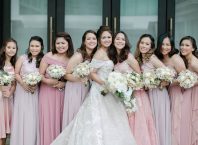(Church Requirements for Mixed Marriages)
By Gladys Pinky D. Tolete
You have black hair and black eyes, your partner has blond highlights and gorgeous blue eyes. You come from different cultures, but now, you come together to be one in the holy sacrament of matrimony of the Catholic Church.
Make sure you don’t miss that important church document that may become the thorn in your rose-filled wedding dream.
Before embarking on a hunting spree for rings and fabric swatches, it is strongly advised that you take care of the church and legal requirements because marrying a foreign citizen entails a bit more paperwork than the usual. Read on and hope you won’t miss that important document that could become a thorn in your rose-filled wedding dream.
A foreign citizen who marries a Filipino needs to secure a clearance certificate from the Archdiocesan Chancery Office (at the Archbishop’s Office, 121 Arzobispo St., Intramuros). Before securing the clearance, you need to have the following documents:
- New copies of Baptismal Certificates of both parties marked “For Marriage Purposes.”
- A copy of Certification of Freedom to Marry from the foreign citizen’s embassy.
- A copy of the Marriage License or Marriage Certificate.
- Military Clearance (if either party is member of the Armed Forces).
- Wedding Banns — the Filipino party should publish wedding banns in his/her parish church. If the foreign citizen lives in the Philippines, he/she will also need to have wedding banns published in his/her parish.
- If the foreign citizen lives abroad, he/she needs to obtain a certification from his/her parish that he/she is a parishioner of good standing. This is in lieu of the wedding bann.
- Dispensation from the parish priest stating that the party is allowed to marry or has no marriage impediment.
- If one party is widowed, a copy of the death certificate of the deceased spouse.
- If one party is divorced or comes from an annulled marriage, the additional documents are required:
- a declaration of nullity from a competent Catholic Marriage Tribunal or from the Bishop in charge of the residence of the party, to confirm that the said party is free to marry.
- For the non-divorced Catholic party: a certification that he/she is free to marry from his/her pastor, or have his/her baptismal certificate marked with “For Marriage Purposes” or have his/her wedding banns published in his/her parish.
- For the non-divorced non-Catholic party: certification from his/her parish that he/she has never been married and that he/she is free from any marriage impediment.
When a Filipino intends to marry a foreign citizen, it is likely that the latter practices a different religion. Hence, the Church has also set requirements for people of different faiths (these requirements also hold true for Filipinos of different religions):
If one party is a non-Catholic Christian (i.e. Protestant, Iglesia ni Cristo, etc. ), the following documents are needed:
- New copies of Baptismal Certificates of both parties marked “For Marriage Purposes.”
- A certification from the Catholic party’s pastor declaring that he/she has never contracted any form of marriage and that he/she is free from any marriage impediment. The Catholic partner would also need to publish banns in his/her parish.
- Marriage license or a marriage certificate if already civilly married.
- If one party is widowed, a copy of the death certificate of the deceased spouse.
- A written permission for mixed marriage from the bishop to validate the celebration of marriage.
If one party is non-Christian or has no religion:
- A new copy of baptismal certificate of the Catholic party marked “For Marriage Purposes.”
- Certification of freedom to marry from the Catholic party’s parish priest that he/she is free to marry or that he/she is free from any marriage impediment. Or, the Catholic party should have wedding banns published in his/her parish.
- To make sure you do not forget anything, consult regularly with the priest of the church where you are getting married.
- For the non-Christian, a certification from his/her embassy (if he/she is a foreigner) or from his/her country that he/she has never been married in any form and that there is no legal hindrance for his/her upcoming marriage.
- Marriage license or marriage certificate.
- Dispensation from the parish priest stating that the party is allowed to marry or has no marriage impediment.
- A written permission from the bishop to validate the celebration of marriage.
To make sure you do not forget anything, consult regularly with the priest of the church where you are getting married. Be patient, for after procuring and completing such documents comes the fun part — planning the wedding!
. . . . . . . . . . . . . . . . . . . . . . . . . . . . . . . . . . . . . . . . . . . . . . . . . . . . . . . . . . . . . . . . . . . . . . .
Sources:
“Cross-cultural Couplings.” Metro Veil. May 2001 Vol.1 No.1. ABS-CBN Publishing
Paguio, Rev. Fr. Wilfredo and Villegas, Monsignor Socrates. “Roman Catholic Wedding.” The Essential Wedding Workbook for the Filipina ed. Rita Neri, 1998




